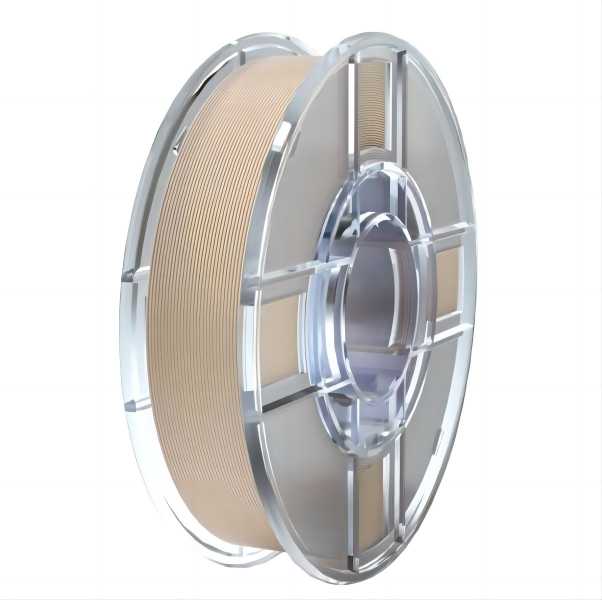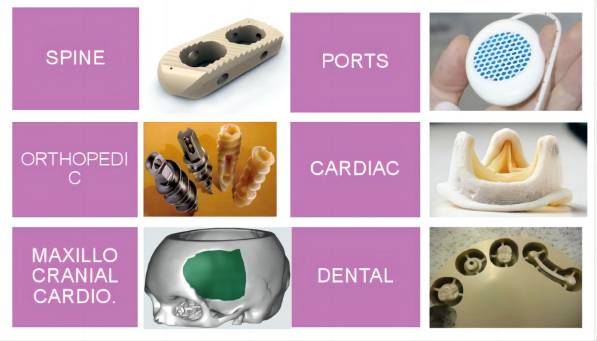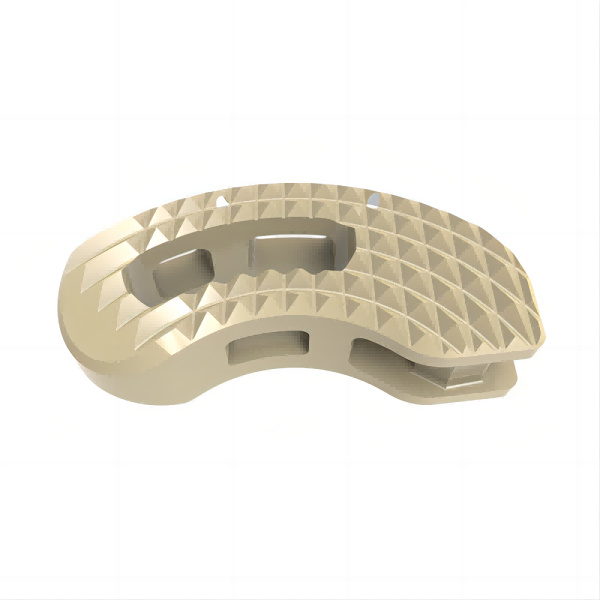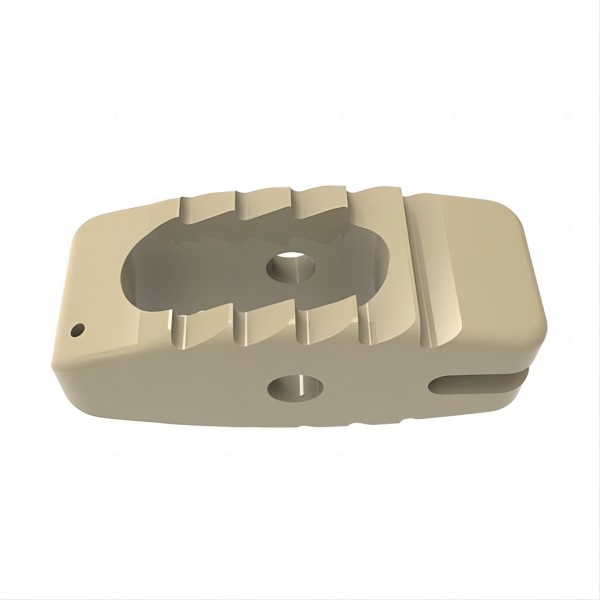
Privacy statement: Your privacy is very important to Us. Our company promises not to disclose your personal information to any external company with out your explicit permission.
Polyetheretherketone PEEK, is a semi-crystalline polyaromatic thermoplastic polymer, has many excellent properties, such as high heat resistance, high mechanical properties and chemical stability, with self-extinguishing, resistance to most chemicals and solvents, resistance to radiation, and has a good biocompatibility of medical peek material in the medical field has been recognized by many medical device manufacturers and surgeons, has been in the field of the spine, trauma and joints for use.
Material wire diameter: 1.75±0.03mm
Net weight of wire: 0.25/0.5/1kg
3D printing peek wire is a suitable for FDM process. As a representative material of specialty plastics, polyether ether ketone peek material has excellent mechanical properties, self-extinguishing, heat resistance, radiation resistance, resistance to corrosion of most chemicals and solvents, and good biocompatibility. This 3D printing peek consumable combines many excellent properties and can be used as a medical implantable grade peek material for precision printing of electronic parts and medical devices.
Material Name: PEEK
Material Diameter: 1.75±0.03mm
Net weight of wire: 0.25/0.5/1kg
Printing temperature: 400℃~450
Platform temperature: 100℃~160
Box temperature: 80℃~140
Printing speed: 20~50mm/s
Implantable grade PEEK product application:
Substitute for titanium alloy plate to make cranial bone patches;
Replacing titanium alloy to make intervertebral fusion to repair the spine;
Instead of titanium alloy or stainless steel to make orthopedic fixation plates;
Medical peek material can be used in dental implant accessories, such as temporary abutment, healing cap, healing abutment, etc..
Production process: Medical FDM high-performance 3D printers


What are the uses of PEEK medical implants?
The excellent material properties of 3D printed PEEK make it suitable for many medical applications, including many implant applications.PEEK medical is the preferred choice for spinal instrumentation, trauma instrumentation, endovascular instrumentation and many other areas of medicine. More medical uses for PEEK are on the horizon as medical device manufacturers and various design and engineering firms continue to explore and improve the material. The rapid rise of implantable grade PEEK in the medical field has made it a major challenger to titanium implants and a leader in many areas.

PEEK has great potential in several medical fields including:
1. Spinal implants - The primary medical application for medical PEEK materials is their use as spinal implants. The material's effectiveness and safety in this role has been proven over many years of applications and research. Today, medical PEEK continues to have an important place in spinal implant surgery, and future developments may make it the most effective option for a wider range of patients.
Patients suffering from degenerative disc disease, degenerative scoliosis, degenerative spondylolisthesis, spinal stenosis or other spine-related conditions can often see significant relief with the use of spinal cages or spacers.
The optimal modulus of implant grade PEEK is very similar to that of cortical bone, and the radiolucency makes it the primary choice for spinal implant procedures. Its modulus ensures that the implant bears weight like natural bone, reducing the likelihood of nearby bone suffering subsidence and density loss. Its radiolucency ensures that surgeons can monitor the progress of both the patient and the implant after surgery. These are essential characteristics that an implant must have, and both can be modified to fit specific applications. If the surgeon wants an implant with low radiopacity, PEEK can be enhanced with a variety of additives, including barium sulfate, to provide better contrast.
2. Trauma Immobilization - The use of PEEK for medical applications in trauma immobilization has become increasingly important recently. Surgeons looking for alternatives to metal components have found medical PEEK materials to be an ideal replacement for the manufacture of bone plates, screws, nails, anchors and more.
The growing role of implant-grade PEEK in trauma fixation is due to the following reasons. First, PEEK bone plates have superior fatigue strength, which extends the fatigue life of implanted components compared to metals such as stainless steel.3D printed PEEK performs well in trauma fixation, also because of its sheer permeability. Surgeons can see exactly how their patients' injured areas react after surgery, allowing them to accurately track and predict the healing process.PEEK's medical bone-like modulus also serves patients well when used as a trauma fixation device. With its modulus, implantable grade PEEK offers an optimal combination of flexibility and stiffness, ensuring that it does not impede the body's own healing process. If desired, medical PEEK implants can be removed more easily than metal components, primarily due to less bone growth with unmodified PEEK.
3. Orthopedics - PEEK is steadily gaining traction in the field of orthopedics, where it can be used for a variety of procedures. This includes knee and hip replacements, as well as partial or total replacement applications.
Why is PEEK medical great for orthopedics? It works well in spine and trauma fixation applications for most of the same reasons. Proper weight bearing is a major goal of the orthopedic surgical team, which must preserve as much of the natural function of the joint as possible. Implant-grade PEEK makes this easier to achieve, as its bone-like modulus ensures that it can bear weight and move like bone. Not surprisingly, radiographic permeability is also important to orthopaedic teams, who must track the body's response to partial or total joint replacements. the radiographic permeability of PEEK allows for extremely accurate image reading.
Another particularly interesting feature of PEEK for medical use in orthopedics is its light weight. Medical PEEK material is much lighter than metal, allowing patients to manipulate joints and limbs more easily than with heavier metals. The difference may be subtle, but patients have reported improved comfort with PEEK components.
4. Cardiovascular - The cardiovascular field continues to explore the purpose of 3D printed PEEK, but the polymer has already played an important role in minimally invasive ventricular augmentation or LIVE surgery. Until recently, the only reliable way to correct cardiac damage after myocardial infarction was a procedure called surgical ventricular repair (SVR). There are many risks associated with SVR, including the risk associated with having to stop the heart from beating during the procedure. Several incisions are also required during SVR, each of which can lead to further damage if the surgeon is not very precise.
LIVE offers a safer alternative to SVR. During the LIVE procedure, a pair of anchors is positioned over the left ventricle, which tends to suffer the most during myocardial infarction. These anchors stabilize the ventricle and ensure that it maintains its function. The anchors are tied together using PEEK tethers to keep the anchors in place relative to each other. The outstanding strength of implantable grade PEEK as a high-performance polymer is key to LIVE, as the tethers are subjected to tremendous stress as the heart continues to beat.
5. Dental - PEEK medical has been widely recognized for its use in dentistry, most commonly in removable partial dentures. 3D printed PEEK performs well in this role for a number of reasons. One of the reasons that stands out is the excellent abrasion and compression resistance of the medical PEEK material, so it can handle chewing and tearing motions. The radiopacity of implant-grade PEEK is also essential for dental professionals, providing patients with unrivaled comfort and aesthetics. Patients report positive results with PEEK dental implants because they can easily look like natural teeth, don't interfere with flavor, feel comfortable, and are less prone to allergic reactions or ulcers.

November 17, 2024
November 16, 2024
August 27, 2021
August 26, 2021
PEEK ball is a special type of ball made of polyether ether ketone (PEEK), which has excellent chemical stability, abrasion resistance, and high temperature resistance.PEEK ball is widely used in...
PVDF Application Areas Different models of PVDF products are suitable for different application scenarios. According to application fields, PVDF can be divided into conventional grade products and...
Application Performance Advantages of MC nylon MC nylon is a new type of engineering plastics, due to its outstanding comprehensive performance, so that its status in engineering plastics is rapidly...
Types of nylon: 1. Nylon - 6 (PA6) Nylon -6, also known as polyamide -6, that is, polycaprolactam. Translucent or opaque opalescent resin. 2. Nylon - 66 (PA66) Nylon-66, also known as polyamide-66,...
Email to this supplier
November 17, 2024
November 16, 2024
August 27, 2021
August 26, 2021

Privacy statement: Your privacy is very important to Us. Our company promises not to disclose your personal information to any external company with out your explicit permission.

Fill in more information so that we can get in touch with you faster
Privacy statement: Your privacy is very important to Us. Our company promises not to disclose your personal information to any external company with out your explicit permission.